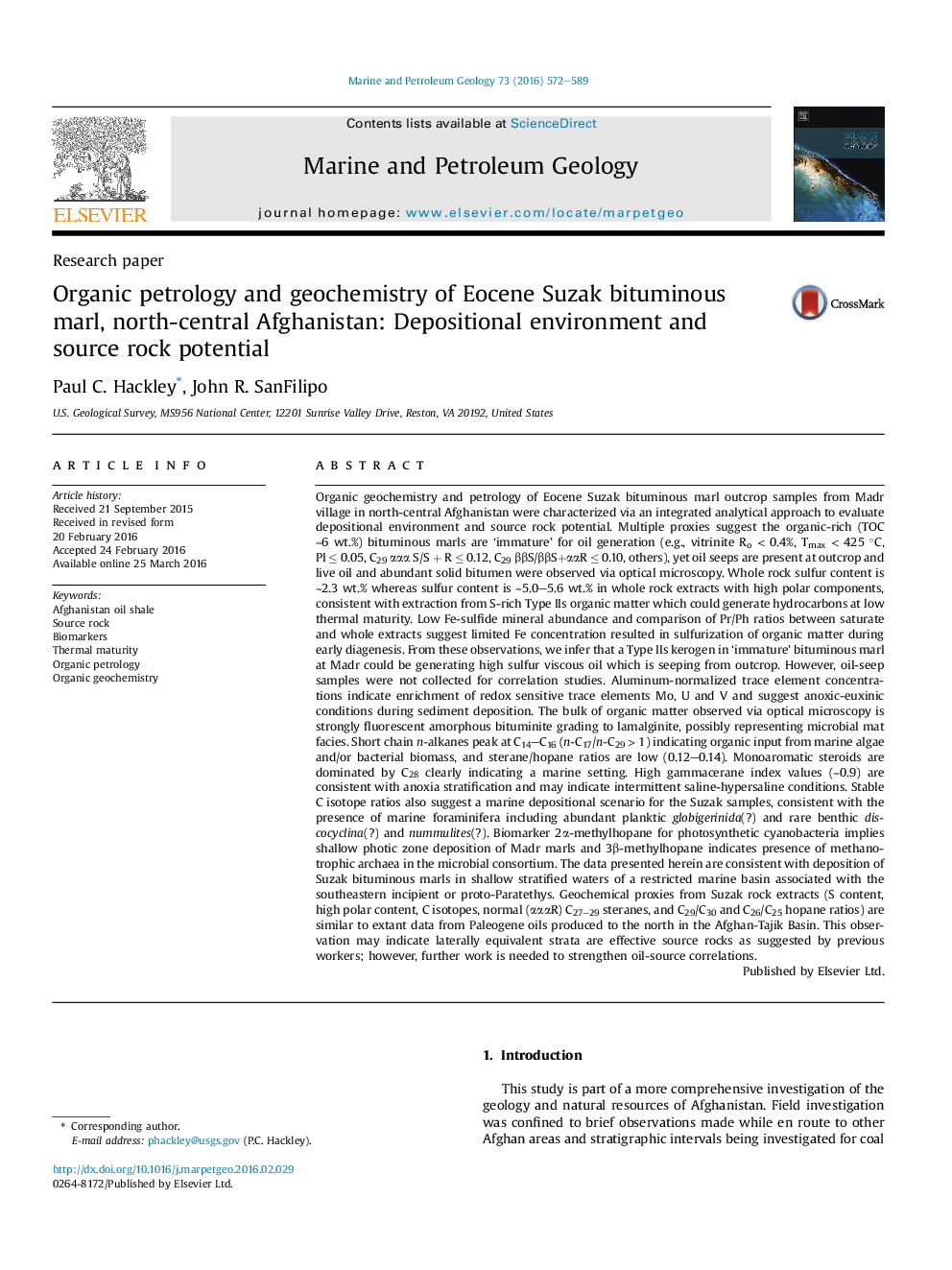| Article ID | Journal | Published Year | Pages | File Type |
|---|---|---|---|---|
| 6434847 | Marine and Petroleum Geology | 2016 | 18 Pages |
â¢Organic-rich marls collected near Madr village in Afghanistan were analyzed.â¢Marine marls are immature based on multiple proxies but contain a Type IIs kerogen.â¢Oil seeps at outcrop are interpreted to be locally sourced from the marls.â¢Marls were deposited in anoxic shallow stratified waters of proto-Paratethys.â¢Geochemical data suggest laterally equivalent strata are effective source rocks.
Organic geochemistry and petrology of Eocene Suzak bituminous marl outcrop samples from Madr village in north-central Afghanistan were characterized via an integrated analytical approach to evaluate depositional environment and source rock potential. Multiple proxies suggest the organic-rich (TOC â¼6 wt.%) bituminous marls are 'immature' for oil generation (e.g., vitrinite Ro < 0.4%, Tmax < 425 °C, PI â¤Â 0.05, C29 ααα S/S + R â¤Â 0.12, C29 ββS/ββS+ααR â¤Â 0.10, others), yet oil seeps are present at outcrop and live oil and abundant solid bitumen were observed via optical microscopy. Whole rock sulfur content is â¼2.3 wt.% whereas sulfur content is â¼5.0-5.6 wt.% in whole rock extracts with high polar components, consistent with extraction from S-rich Type IIs organic matter which could generate hydrocarbons at low thermal maturity. Low Fe-sulfide mineral abundance and comparison of Pr/Ph ratios between saturate and whole extracts suggest limited Fe concentration resulted in sulfurization of organic matter during early diagenesis. From these observations, we infer that a Type IIs kerogen in 'immature' bituminous marl at Madr could be generating high sulfur viscous oil which is seeping from outcrop. However, oil-seep samples were not collected for correlation studies. Aluminum-normalized trace element concentrations indicate enrichment of redox sensitive trace elements Mo, U and V and suggest anoxic-euxinic conditions during sediment deposition. The bulk of organic matter observed via optical microscopy is strongly fluorescent amorphous bituminite grading to lamalginite, possibly representing microbial mat facies. Short chain n-alkanes peak at C14-C16 (n-C17/n-C29 > 1) indicating organic input from marine algae and/or bacterial biomass, and sterane/hopane ratios are low (0.12-0.14). Monoaromatic steroids are dominated by C28 clearly indicating a marine setting. High gammacerane index values (â¼0.9) are consistent with anoxia stratification and may indicate intermittent saline-hypersaline conditions. Stable C isotope ratios also suggest a marine depositional scenario for the Suzak samples, consistent with the presence of marine foraminifera including abundant planktic globigerinida(?) and rare benthic discocyclina(?) and nummulites(?). Biomarker 2α-methylhopane for photosynthetic cyanobacteria implies shallow photic zone deposition of Madr marls and 3β-methylhopane indicates presence of methanotrophic archaea in the microbial consortium. The data presented herein are consistent with deposition of Suzak bituminous marls in shallow stratified waters of a restricted marine basin associated with the southeastern incipient or proto-Paratethys. Geochemical proxies from Suzak rock extracts (S content, high polar content, C isotopes, normal (αααR) C27-29 steranes, and C29/C30 and C26/C25 hopane ratios) are similar to extant data from Paleogene oils produced to the north in the Afghan-Tajik Basin. This observation may indicate laterally equivalent strata are effective source rocks as suggested by previous workers; however, further work is needed to strengthen oil-source correlations.
